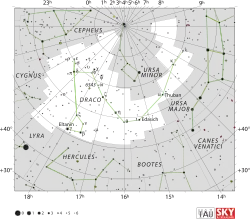Kappa Draconis
Kappa Draconis, Latinized from κ Draconis, is a blue giant star located in the northern circumpolar constellation of Draco. At an apparent magnitude of 3.88, it is barely visible to the naked eye when artificial lighting from cities is present. Nevertheless, it is a powerful star, approximately five time as massive as the Sun. It is about 490 light-years away, and is 1,400 times brighter than the Sun.

| |
| Observation data Epoch J2000 Equinox J2000 | |
|---|---|
| Constellation | Draco |
| Right ascension | 12h 33m 28.94325s[1] |
| Declination | +69° 47′ 17.6490″[1] |
| Apparent magnitude (V) | 3.82[2] |
| Characteristics | |
| Spectral type | B6 IIIe[3] |
| U−B color index | –0.61[2] |
| B−V color index | –0.11[2] |
| Astrometry | |
| Radial velocity (Rv) | –11.4[4] km/s |
| Proper motion (μ) | RA: –58.79[1] mas/yr Dec.: +10.68[1] mas/yr |
| Parallax (π) | 6.65 ± 0.34[1] mas |
| Distance | 490 ± 30 ly (150 ± 8 pc) |
| Absolute magnitude (MV) | −2.03[5] |
| Details | |
| Radius | 5.6[6] R☉ |
| Luminosity | 1,115[5] L☉ |
| Temperature | 13,800[3] K |
| Metallicity [Fe/H] | −0.65[5] dex |
| Rotational velocity (v sin i) | 250[3] km/s |
| Other designations | |
| Database references | |
| SIMBAD | data |
Kappa is thought to be just entering its red giant phase, having exhausted the supply of hydrogen in its core. Over the next several thousand years, the star will expand, becoming more powerful but with a much cooler surface temperature. Tens of thousands of years from now, Kappa Draconis will appear much brighter, probably shining with a reddish hue.
The star is currently located at declination 69° 47' 18" North (RA 12h 33m 29.0s), but due to the effects of precession, Kappa Draconis was the nearest star to the North Celestial Pole visible to the naked eye from 1793 BC to approximately 1000 BC, though it was 6° removed from perfect alignment, making it only an approximate pole star, similar to the roughly 7° variance from perfect alignment of the much brighter (magnitude 2.08) star Kochab, at the same time during Earth's precession.
Chinese name
In Chinese, 紫微右垣 (Zǐ Wēi Yòu Yuán), meaning Right Wall of Purple Forbidden Enclosure, refers to an asterism consisting of κ Draconis, α Draconis, λ Draconis, 24 Ursae Majoris, 43 Camelopardalis, α Camelopardalis and BK Camelopardalis.[8] Consequently, the Chinese name for κ Draconis itself is 紫微右垣二 (Zǐ Wēi Yòu Yuán èr, English: the Second Star of Right Wall of Purple Forbidden Enclosure.),[9] representing 少尉 (Shǎowèi), meaning Second Chief Judge[10]
References
- van Leeuwen, F. (November 2007), "Validation of the new Hipparcos reduction", Astronomy and Astrophysics, 474 (2): 653–664, arXiv:0708.1752, Bibcode:2007A&A...474..653V, doi:10.1051/0004-6361:20078357
- Crawford, D. L.; Barnes, J. V.; Golson, J. C. (1971), "Four-color, H-beta, and UBV photometry for bright B-type stars in the northern hemisphere", The Astronomical Journal, 76: 1058, Bibcode:1971AJ.....76.1058C, doi:10.1086/111220
- Balona, L. A.; Dziembowski, W. A. (October 1999), "Excitation and visibility of high-degree modes in stars", Monthly Notices of the Royal Astronomical Society, 309 (1): 221–232, Bibcode:1999MNRAS.309..221B, doi:10.1046/j.1365-8711.1999.02821.x
- Wilson, R. E. (1953). General Catalogue of Stellar Radial Velocities. Carnegie Institute of Washington D.C. Bibcode:1953GCRV..C......0W.
- Anderson, E.; Francis, Ch. (2012), "XHIP: An extended hipparcos compilation", Astronomy Letters, 38 (5): 331, arXiv:1108.4971, Bibcode:2012AstL...38..331A, doi:10.1134/S1063773712050015.
- Underhill, A. B.; et al. (November 1979), "Effective temperatures, angular diameters, distances and linear radii for 160 O and B stars", Monthly Notices of the Royal Astronomical Society, 189: 601–605, Bibcode:1979MNRAS.189..601U, doi:10.1093/mnras/189.3.601
- "kap Dra -- Be Star", SIMBAD, Centre de Données astronomiques de Strasbourg, retrieved 2012-02-06
- (in Chinese) 中國星座神話, written by 陳久金. Published by 台灣書房出版有限公司, 2005, ISBN 978-986-7332-25-7.
- (in Chinese) AEEA (Activities of Exhibition and Education in Astronomy) 天文教育資訊網 2006 年 6 月 11 日
- English-Chinese Glossary of Chinese Star Regions, Asterisms and Star Name Archived 2008-09-24 at the Wayback Machine, Hong Kong Space Museum. Accessed on line November 23, 2010.